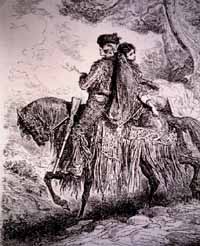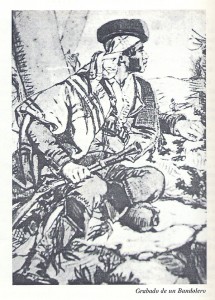Bandoleros Posted by Magda on Sep 16, 2010 in Spanish Culture
Historic events often facilitate the formation of social groups and characters that turn into either heroes or villains. When these become important, art, literature, and even music, all contribute to their immortality. This is what happened in Spain with the figure of the bandit.
Just like in many other countries, bandits, criminals, and smugglers have existed since ancient times, especially in times of war and famine, but in Spain they became particularly relevant during the French invasion in the 19th century. The Spanish resistance had to take to the hills when Napoleon’s troops entered the country, and the difficult situation for townsfolk made pillage a more appealing option.
European romantic travelers, especially Frenchmen such as Gautier, Dumas, Davillier, or Doré, were the ones who changed the stereotype about Spain as a backwards, superstitious, and ignorant country, thus sparking curiosity among their contemporaries. They came to Spain and traveled alone hoping they would come across a bandit.  They went along roads and paths, all the way to the mountainous regions of Ronda and Sierra Morena, where the bandits had their hideouts. They created the typical figure of the bandit as a highway man, robbing the rich to give to the poor. They showed how their culture was tied to bullfighting and even art, as the flirting with a dark-hair woman reflected by Prosper Mérimée in his novel Carmen.
They went along roads and paths, all the way to the mountainous regions of Ronda and Sierra Morena, where the bandits had their hideouts. They created the typical figure of the bandit as a highway man, robbing the rich to give to the poor. They showed how their culture was tied to bullfighting and even art, as the flirting with a dark-hair woman reflected by Prosper Mérimée in his novel Carmen.
However, reality was not always that romantic, so let’s meet some of the real bandits of the time:
Jose Ulloa Navarro, aka Tragabuches, from the gang of the Seven Children of Ecija, was a banderillero (a bullfighter’s helper who sticks banderillas into the bull’s back) before turning to smuggling in partnership with his lover, Maria “La Nena”. He became a bandit, as the story goes, after a violent crime of passion, and he was one of the most fearsome ones.
Jose Maria Pelagio Hinojosa Cobacho, “El Tempranillo”, the most admired bandit among the poor, fled to the Sierra after killing a rich young master who was courting his girlfriend. He had a gang of over 50 men, and they took to assaulting carriages and stagecoaches. He used to share his loot with those in need, fought against rich local bosses and landowners, and he wasn’t as violent as other bandits. He was killed by one of his men, leaving his legend as his legacy.
Finally, although I leave without mentioning many others, is Andres Lopez, or the boatman of Cantillana who, after a series of legal disputes, had to leave his job and became a bandit. He inspired the famous TV series Curro Jimenez. Who in Spain doesn’t remember the Algarrobo, the Student, the Gypsy, and of course the leader of the gang, Curro Jimenez, who provided us with so many good times in our childhood? I’ll leave you with them…
http://www.youtube.com/watch?v=-fXwJEttlXM
Los acontecimientos históricos suelen facilitar la aparición de grupos sociales, y personajes que encarnan tanto a héroes como a villanos. Cuando estos cobran importancia, el arte, la literatura, incluso la música, ayudan a inmortalizarlos. Esto es lo que ha ocurrido en España con la figura del bandolero.
Al igual que en muchos otros países, los bandoleros, malhechores y contrabandistas han existido desde la Antigüedad, sobre todo en épocas de hambruna y guerra, pero en España fue en el marco de la invasión francesa durante el siglo XIX cuando adquirieron especial relevancia. La resistencia española tuvo que refugiarse en montes a la entrada de Napoleón al país, y la difícil situación del pueblo favoreció que más gente se dedicase al pillaje.
Los viajeros románticos europeos, sobre todo los franceses como Gautier, Dumas, Davillier o Doré, fueron quienes cambiaron la visión que se tenía de este país atrasado, supersticioso e inculto, incentivando la curiosidad de sus contemporáneos. Venían a España, y viajaban solos con la única esperanza de toparse con un bandolero. Recorrieron caminos, llegando hasta la Serranía de Ronda y Sierra Morena, donde estos se ocultaban. Dieron vida al tópico del bandido salteador de caminos, que robaba al rico para aliviar al pueblo. Mostraron cómo estaba ligado al mundo del toreo e incluso del arte, rondando de amores a la mujer morena que Próspero Mérimée reflejó en su novela Carmen.
Sin embargo, la realidad no fue siempre tan pintoresca, así que mejor conocemos a algún bandolero que nos ilustre:
 José Ulloa Navarro “Tragabuches”, de la partida de los Siete Niños de Écija, fue banderillero hasta que se dedicó al contrabando junto a su amante, María “La Nena”. Cuentan que se convirtió en bandolero tras un sangriento crimen pasional, y fue de los más temidos.
José Ulloa Navarro “Tragabuches”, de la partida de los Siete Niños de Écija, fue banderillero hasta que se dedicó al contrabando junto a su amante, María “La Nena”. Cuentan que se convirtió en bandolero tras un sangriento crimen pasional, y fue de los más temidos.
José María Pelagio Hinojosa Cobacho, “El Tempranillo”, el bandolero más querido por los pobres, quien se ocultó en Sierra Morena tras matar a un señorito que pretendía a su novia. Tuvo a más de 50 hombres en su partida, y se dedicó a asaltar carruajes y diligencias. Fué el bandolero más querido por los pobres, ya que compartía botín con los necesitados, luchó contra caciques y latifundistas, y no fue violento como el resto. Murió a manos de un compañero, dejando una leyenda tras él.
Y en tercer lugar, aunque dejo a muchos sin nombrar, Andrés López, o el barquero de Cantillana, quien por pleitos con la justicia, tuvo que abandonar su oficio por el de bandolero. El inspiró la famosa serie de “Curro Jiménez”. ¿Quién no recuerda al Algarrobo, al Estudiante, al Gitano y por supuesto al jefe de la cuadrilla, Curro Jiménez, que tan buenos ratos nos hicieron pasar en nuestra infancia? Pues con ellos me marcho…

Build vocabulary, practice pronunciation, and more with Transparent Language Online. Available anytime, anywhere, on any device.



